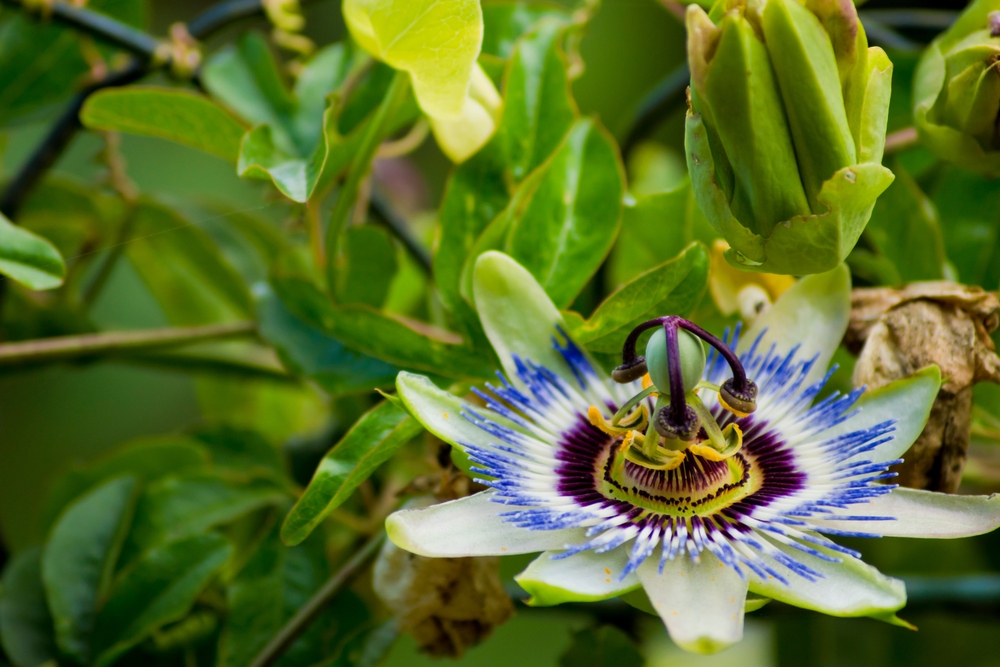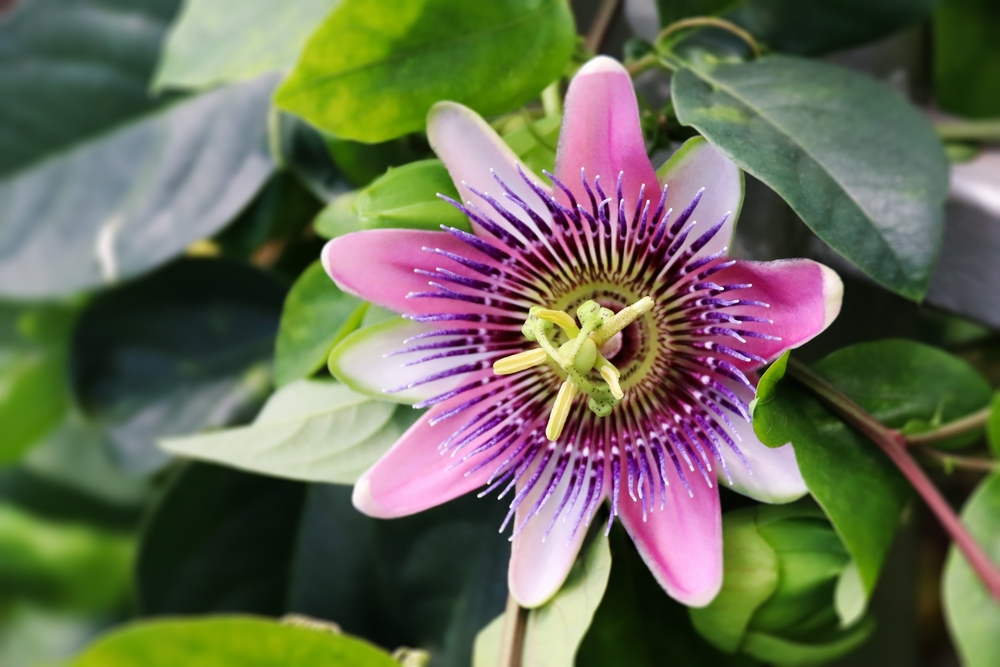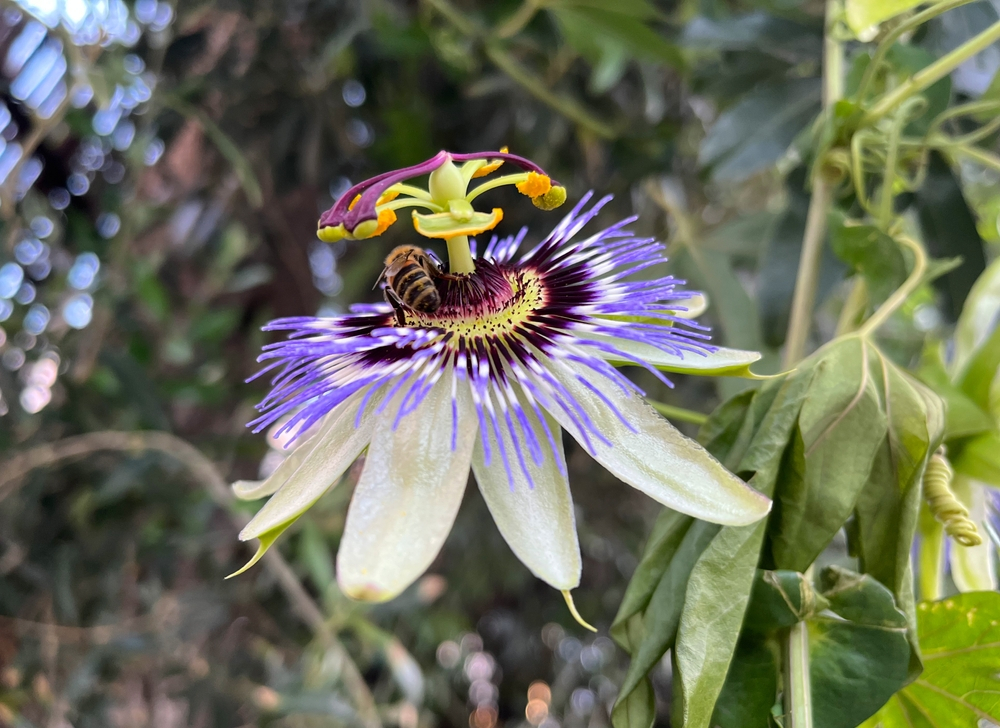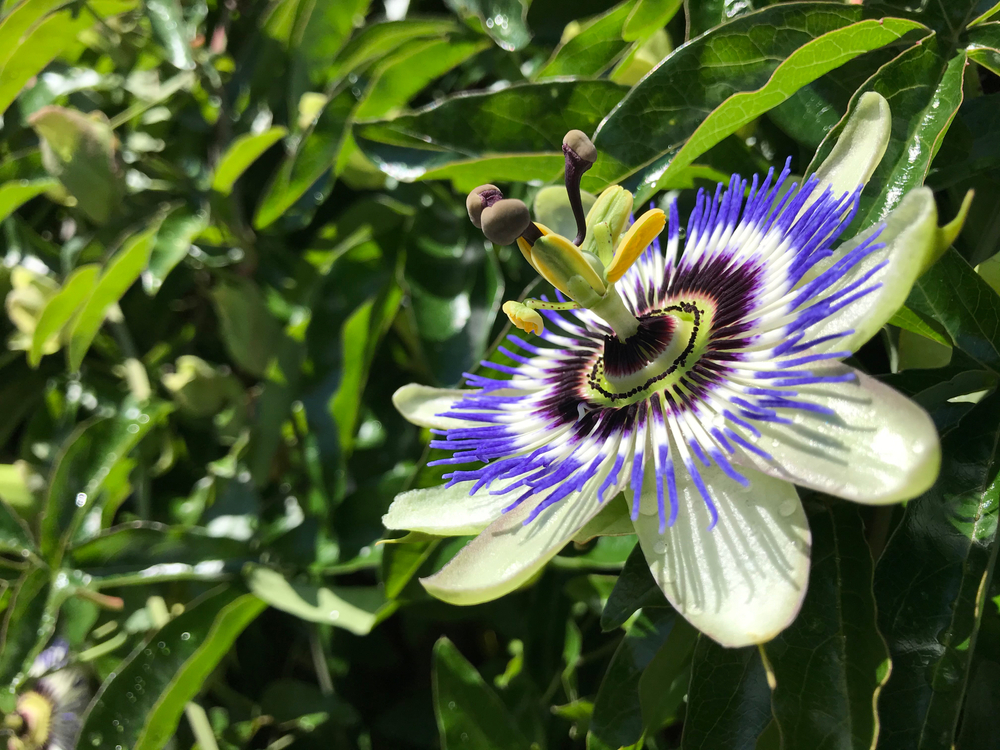
The Passiflora Caerulea flower is also known as Blue Passion Flower or Bluecrown Passion Flower. The flowering plant is primarily grown for its exotic-looking flowers. It is a climber from the Passifloraceae family. The plant is native to South America. The perennial vine can grow up to ten meters in length. However, depending on the climate and the care provided, it can reach a height of 25 meters. Flowers bloom on the vine primarily during the summer months.
In Japan, the Passiflora caerulea flower is commonly known as the "clock plant" due to its shape. The plant's fruit is oval-shaped and orange-yellow in colour. When ripe, the fruit can be eaten, but it contains more seeds than pulp. The Blue Passion flower's berries have a fairly bland flavor when compared to the fruits of other passion flowers. However, it is used as a flavoring in teas, beverages, ice cream, and marmalades. Passionflowers are also known for their medicinal properties. Passiflora caerulea tea is known for its medicinal properties.
If you intend to grow this plant, you will find the information provided here useful. We have provided information on how to grow and care for the Passiflora caerulea flower. We also discuss the two types of Bluecrown Passion flowers.
Here are some important facts about the Passiflora Caerulea flower:
| Particulars | Description |
| Scientific name | Passiflora Caerulea |
| Other names | Passionflower, blue passion flower, passion fruit, Jesus flower |
| Indian name of Passiflora Caerulea | Krishan Kamal |
| Native | South and North America |
| Best season to plant blue passion flower | Krishan Kamal (Indian name) can be nurtured in any month. |
| Bloom season | Summer is the flowering season for Blue Passion Flower. |
| Height of the plant | Grows up to 30 feet |
| Water requirement | Once or twice a week |
| Light requirement | Direct or partial sunlight for 4-5 hours |
| Soil | Well drained soil |
| Toxicity | Remember, only ripe fruit is edible |

The Blue Crown Passion flower is one of the most commonly grown varieties. It is a rapidly growing plant. The vine spreads quickly, covering the fences, trellises, and pillars that support it. The gorgeous Passiflora Caerulea flowers typically measure 8-10 cm in diameter. These have a distinctive crown-like structure in the center. Their name derives from this structure. The petals of this flower are white or light blue in color. On the other hand, the crown is made up of blue and white filaments. This plant is also known for producing edible fruit. The fruit it produces is very similar to an orange.
As the name implies, this is a miniature version of the Bluecrown Passion Flower. It is mostly about 2-3 cm in diameter. It has a crown-like structure in the center, similar to the Bluecrown Passion Flower. It is ideal for smaller spaces.
The Hindi name for Passiflora Caerulea is Krishna Kamal. Krishna Kamal's name refers to its association with Lord Krishna. Its yellow-green circular stamen are thought to symbolize Krishna's sudarshan chakra. While its five yellow anthers are said to be Pandavas, the 100 blue filaments around it are thought to be Kauravas. As a result of this story, the plant was named Krishna Kamal.

The Passiflora Caerulea flower is aesthetically pleasing. Adding this beautiful vine to your home garden can greatly increase its appeal. The captivating aroma of the flower adds to the outdoor atmosphere. Though native to South America, the plant is easily grown in India. With some care, you can see the Passiflora caerulea vine grow and its lovely flowers bloom in your garden. The following tips can help those of you who want to grow Passiflora caerulea.
Before you proceed, you should be aware that it can be grown from both stem cuttings and seeds. Now, let's start with the step-by-step procedure to propagate this stunning, blue-colored flower:
Get the Seeds: Start by gathering the seeds. Passion fruit is an excellent source of seeds. Just make sure the fruit is ripe before touching the seeds. Before proceeding, the seeds must be thoroughly washed and dried. Alternatively, you can buy the seeds online or at a local nursery.
Soak and clean the seeds: Next, soak them in warm water overnight. Discard those that float in the water. Clean the remainder of them gently to remove any dirt or debris. Be careful not to damage the seeds. This process can be carried out with tissue paper or sandpaper.
Germinate the Seeds: Fill a small pot with moist soil and manure. Now, spread the seeds across the soil's surface. Make sure the seeds are not buried in the soil, as they require enough light to germinate. Wrap a clear plastic bag around the pot to retain moisture and promote germination. Place the wrapped pot in a warm spot out of direct sunlight.
Keep a tab: Check the seeds to see if they have sprouted. Seeds typically germinate within two months. When they sprout and small leaves appear, expose them to direct sunlight.
Time to Repot: When you notice a good number of leaves, it's time to repot it in a large flower pot or your garden. The vine will bloom in both partial shade and full sunlight. As a result, you can choose an appropriate location. It should be grown near a fence, pillar, or other structure that allows the vine to climb.
You can propagate this plant using stem cuttings. The best time to take stem cuttings is in the spring, when the vine is fully bloomed.
Cut a piece of the stem from the vine (about 15 cms long)
Remove all of the leaves from the base of the stem.
Place the cutting in a damp potting soil.
Keep it in a warm place so the plant can grow.

To ensure that the Passiflora caerulea flower vine grows and blossoms, it must be properly cared for. Here are some useful tips to care for this plant:
Careful Watering - The Passiflora caerulea plant can thrive in dry environments. It doesn't require much watering. Frequent watering can cause the roots to rot. It is recommended to water it every two weeks. If you keep it in direct sunlight, you may need to water it more frequently.
Pruning - It is necessary to prune the passion flower vine at least once a year. This plant dries out partially during the winter, making it the best time to prune it. You can remove the dried and overgrown parts to promote new growth. Early spring is also a suitable time for pruning this plant.
Winter Care - Protecting the plant as the temperature drops and the weather becomes colder outside is critical. It is a good idea to spread mulch around its roots. This will provide much-needed frost resistance.
Provide Support - Provide adequate support for the vine so that it can climb quickly and grow upward.
Keep the Pests Away - Passion flowers attract whiteflies, spiders, and other pests. You should use the appropriate pesticides to repel them and protect your plant.
According to Vastu principles, a Passiflora Caerula should be planted in the northeast or north direction to promote peace, happiness, and wealth in the home. The directions to avoid are west and south.
Get 10 Vastu Tips for Bedroom Attached Bathroom & Toilet
Yes, Passiflora Caerulea is an edible flower. Once the passion flower is ripped, it can be eaten. However, you should avoid eating it raw because it can cause health issues.
Passiflora Caerulea has received the Royal Horticulture Society's prestigious Award of Garden Merit (AGM). This plant has its roots in Christian mythology, as it represents Jesus Christ's crucifixion, and the flower's corona resembles Jesus' thorny crown of thorns.
In Indian mythology, the passion flower is known as the Krishna Kamal, the 100 corona filaments represent the Kauravas, and the greenish bulb is Draupadi. In Hindu mythology, the three stigmas are Brahma, Vishnu, and Mahesh, with Krishna's Sudarshan Chakra serving as its central structure.
Check out 5 Home Buying Myths that you need to Avoid
The Blue Passionflower is used in medicines because it has numerous benefits.
This raw fruit is beneficial for digestion. Also, when combined, its roots and leaves are used to treat dysentery and other gastrointestinal infections and problems. The plant also has anti-inflammatory properties.
In the West Indies, Mexico, and the Netherlands, its leaves and roots are used to make tea and for deworming.
In Brazil and Mauritius, the fruit of the Blue Passionflower is used to treat insomnia. It is also used to treat anxiety disorders.
The leaves and stems of the Passiflora caerulea flower are used in Argentina to treat respiratory diseases such as pneumonia and catarrh.
This plant has long been used in Indian Ayurveda as a natural remedy for anxiety, depression, stress, and brain disorders.
However, one must exercise caution when using this flower because it contains cyanide compounds, which can be fatal. Although boiling can usually remove the majority of these compounds, it is not recommended to use it alone.
Passiflora Caerulea is undeniably one of the most beautiful flowers. It is easy to cultivate. With proper care, the Passiflora Caerulea vine spreads quickly and produces lovely flowers that add beauty to your garden. Their sweet aroma gives the place an enchanting vibe. Not to mention, it has medicinal properties. Passiflora Caerulea tea is known for calming the mind and reducing anxiety. As a result, it is widely popular throughout the world. However, the flower should not be used for healing without professional advice.
The most recent trend in bedroom wall colour combinations is to use two colours. A two-color combination for bedroom walls results in an elegant room [...]
Mukesh Ambani, India’s richest man, and his daughter, Isha Ambani, married Anand Piramal in an extravagant ceremony in December 2018. Isha, who has moved into [...]
The PM House, India’s most prestigious property, is located at 7 Lok Kalyan Marg, previously known as 7 Race Course Road. This is where the [...]

© IndexTap 2023. Powered by CRE Matrix